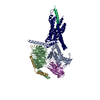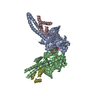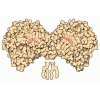+ データを開く
データを開く
- 基本情報
基本情報
| 登録情報 | データベース: PDB / ID: 6pb0 | |||||||||
|---|---|---|---|---|---|---|---|---|---|---|
| タイトル | Cryo-EM structure of Urocortin 1-bound Corticotropin-releasing factor 1 receptor in complex with Gs protein and Nb35 | |||||||||
 要素 要素 |
| |||||||||
 キーワード キーワード | SIGNALING PROTEIN / Corticotropin-releasing factor 1 receptor / urocortins1 / Gs protein / GPCR | |||||||||
| 機能・相同性 |  機能・相同性情報 機能・相同性情報: / corticotropin-releasing hormone binding / histone deacetylase inhibitor activity / regulation of corticosterone secretion / corticotrophin-releasing factor receptor activity / corticotropin-releasing hormone receptor 2 binding / corticotropin secretion / positive regulation of corticotropin secretion / general adaptation syndrome, behavioral process / positive regulation of behavioral fear response ...: / corticotropin-releasing hormone binding / histone deacetylase inhibitor activity / regulation of corticosterone secretion / corticotrophin-releasing factor receptor activity / corticotropin-releasing hormone receptor 2 binding / corticotropin secretion / positive regulation of corticotropin secretion / general adaptation syndrome, behavioral process / positive regulation of behavioral fear response / cellular response to corticotropin-releasing hormone stimulus / parturition / varicosity / negative regulation of voltage-gated calcium channel activity / negative regulation of hormone secretion / positive regulation of cAMP-mediated signaling / behavioral response to ethanol / response to auditory stimulus / drinking behavior / fear response / negative regulation of appetite / corticotropin-releasing hormone receptor 1 binding / neuropeptide hormone activity / positive regulation of vascular permeability / negative regulation of cell size / G protein-coupled peptide receptor activity / Class B/2 (Secretin family receptors) / exploration behavior / adrenal gland development / negative regulation of feeding behavior / response to pain / positive regulation of calcium ion import / startle response / associative learning / PKA activation in glucagon signalling / social behavior / hair follicle placode formation / developmental growth / neuropeptide signaling pathway / positive regulation of collagen biosynthetic process / D1 dopamine receptor binding / Synthesis, secretion, and deacylation of Ghrelin / intracellular transport / T cell migration / D2 dopamine receptor binding / Adenylate cyclase inhibitory pathway / renal water homeostasis / positive regulation of protein localization to cell cortex / Hedgehog 'off' state / regulation of cAMP-mediated signaling / G protein-coupled serotonin receptor binding / adenylate cyclase-activating adrenergic receptor signaling pathway / activation of adenylate cyclase activity / response to glucocorticoid / cellular response to forskolin / axon terminus / regulation of mitotic spindle organization / regulation of synaptic transmission, glutamatergic / cellular response to glucagon stimulus / positive regulation of cardiac muscle contraction / negative regulation of blood pressure / adenylate cyclase activator activity / regulation of insulin secretion / aerobic respiration / adenylate cyclase-inhibiting G protein-coupled receptor signaling pathway / trans-Golgi network membrane / positive regulation of DNA replication / positive regulation of translation / Regulation of insulin secretion / female pregnancy / G protein-coupled receptor binding / negative regulation of inflammatory response to antigenic stimulus / sensory perception of sound / bone development / G-protein beta/gamma-subunit complex binding / Olfactory Signaling Pathway / adenylate cyclase-modulating G protein-coupled receptor signaling pathway / Activation of the phototransduction cascade / adenylate cyclase-activating G protein-coupled receptor signaling pathway / G beta:gamma signalling through PLC beta / Presynaptic function of Kainate receptors / Thromboxane signalling through TP receptor / G protein-coupled acetylcholine receptor signaling pathway / G protein activity / G-protein activation / platelet aggregation / Activation of G protein gated Potassium channels / Inhibition of voltage gated Ca2+ channels via Gbeta/gamma subunits / Prostacyclin signalling through prostacyclin receptor / response to peptide hormone / Glucagon signaling in metabolic regulation / G beta:gamma signalling through CDC42 / cognition / G beta:gamma signalling through BTK / ADP signalling through P2Y purinoceptor 12 / Sensory perception of sweet, bitter, and umami (glutamate) taste / Synthesis, secretion, and inactivation of Glucagon-like Peptide-1 (GLP-1) / photoreceptor disc membrane / Glucagon-type ligand receptors / Adrenaline,noradrenaline inhibits insulin secretion 類似検索 - 分子機能 | |||||||||
| 生物種 |  Homo sapiens (ヒト) Homo sapiens (ヒト)synthetic construct (人工物) | |||||||||
| 手法 | 電子顕微鏡法 / 単粒子再構成法 / クライオ電子顕微鏡法 / 解像度: 3 Å | |||||||||
 データ登録者 データ登録者 | Ma, S. / Shen, Q. / Zhao, L.-H. / Mao, C. / Zhou, X.E. / Shen, D.-D. / de Waal, P.W. / Bi, P. / Li, C. / Jiang, Y. ...Ma, S. / Shen, Q. / Zhao, L.-H. / Mao, C. / Zhou, X.E. / Shen, D.-D. / de Waal, P.W. / Bi, P. / Li, C. / Jiang, Y. / Wang, M.-W. / Sexton, P.M. / Wootten, D. / Melcher, K. / Zhang, Y. / Xu, H.E. | |||||||||
| 資金援助 |  米国, 米国,  中国, 2件 中国, 2件
| |||||||||
 引用 引用 |  ジャーナル: Mol Cell / 年: 2020 ジャーナル: Mol Cell / 年: 2020タイトル: Molecular Basis for Hormone Recognition and Activation of Corticotropin-Releasing Factor Receptors. 著者: Shanshan Ma / Qingya Shen / Li-Hua Zhao / Chunyou Mao / X Edward Zhou / Dan-Dan Shen / Parker W de Waal / Peng Bi / Chuntao Li / Yi Jiang / Ming-Wei Wang / Patrick M Sexton / Denise Wootten / ...著者: Shanshan Ma / Qingya Shen / Li-Hua Zhao / Chunyou Mao / X Edward Zhou / Dan-Dan Shen / Parker W de Waal / Peng Bi / Chuntao Li / Yi Jiang / Ming-Wei Wang / Patrick M Sexton / Denise Wootten / Karsten Melcher / Yan Zhang / H Eric Xu /    要旨: Corticotropin-releasing factor (CRF) and the three related peptides urocortins 1-3 (UCN1-UCN3) are endocrine hormones that control the stress responses by activating CRF1R and CRF2R, two members of ...Corticotropin-releasing factor (CRF) and the three related peptides urocortins 1-3 (UCN1-UCN3) are endocrine hormones that control the stress responses by activating CRF1R and CRF2R, two members of class B G-protein-coupled receptors (GPCRs). Here, we present two cryoelectron microscopy (cryo-EM) structures of UCN1-bound CRF1R and CRF2R with the stimulatory G protein. In both structures, UCN1 adopts a single straight helix with its N terminus dipped into the receptor transmembrane bundle. Although the peptide-binding residues in CRF1R and CRF2R are different from other members of class B GPCRs, the residues involved in receptor activation and G protein coupling are conserved. In addition, both structures reveal bound cholesterol molecules to the receptor transmembrane helices. Our structures define the basis of ligand-binding specificity in the CRF receptor-hormone system, establish a common mechanism of class B GPCR activation and G protein coupling, and provide a paradigm for studying membrane protein-lipid interactions for class B GPCRs. | |||||||||
| 履歴 |
|
- 構造の表示
構造の表示
| ムービー |
 ムービービューア ムービービューア |
|---|---|
| 構造ビューア | 分子:  Molmil Molmil Jmol/JSmol Jmol/JSmol |
- ダウンロードとリンク
ダウンロードとリンク
- ダウンロード
ダウンロード
| PDBx/mmCIF形式 |  6pb0.cif.gz 6pb0.cif.gz | 215.2 KB | 表示 |  PDBx/mmCIF形式 PDBx/mmCIF形式 |
|---|---|---|---|---|
| PDB形式 |  pdb6pb0.ent.gz pdb6pb0.ent.gz | 165.3 KB | 表示 |  PDB形式 PDB形式 |
| PDBx/mmJSON形式 |  6pb0.json.gz 6pb0.json.gz | ツリー表示 |  PDBx/mmJSON形式 PDBx/mmJSON形式 | |
| その他 |  その他のダウンロード その他のダウンロード |
-検証レポート
| 文書・要旨 |  6pb0_validation.pdf.gz 6pb0_validation.pdf.gz | 1.2 MB | 表示 |  wwPDB検証レポート wwPDB検証レポート |
|---|---|---|---|---|
| 文書・詳細版 |  6pb0_full_validation.pdf.gz 6pb0_full_validation.pdf.gz | 1.2 MB | 表示 | |
| XML形式データ |  6pb0_validation.xml.gz 6pb0_validation.xml.gz | 34.3 KB | 表示 | |
| CIF形式データ |  6pb0_validation.cif.gz 6pb0_validation.cif.gz | 51.8 KB | 表示 | |
| アーカイブディレクトリ |  https://data.pdbj.org/pub/pdb/validation_reports/pb/6pb0 https://data.pdbj.org/pub/pdb/validation_reports/pb/6pb0 ftp://data.pdbj.org/pub/pdb/validation_reports/pb/6pb0 ftp://data.pdbj.org/pub/pdb/validation_reports/pb/6pb0 | HTTPS FTP |
-関連構造データ
- リンク
リンク
- 集合体
集合体
| 登録構造単位 | 
|
|---|---|
| 1 |
|
- 要素
要素
-Guanine nucleotide-binding protein ... , 3種, 3分子 ABG
| #3: タンパク質 | 分子量: 43897.789 Da / 分子数: 1 / Mutation: A212G, S352A / 由来タイプ: 組換発現 / 由来: (組換発現)  Homo sapiens (ヒト) / 遺伝子: GNAS, GNAS1, GSP, GNAI1 Homo sapiens (ヒト) / 遺伝子: GNAS, GNAS1, GSP, GNAI1発現宿主:  参照: UniProt: P63092, UniProt: P63096 |
|---|---|
| #4: タンパク質 | 分子量: 37915.496 Da / 分子数: 1 / 由来タイプ: 組換発現 / 由来: (組換発現)  Homo sapiens (ヒト) / 遺伝子: GNB1 Homo sapiens (ヒト) / 遺伝子: GNB1発現宿主:  参照: UniProt: P62873 |
| #5: タンパク質 | 分子量: 7861.143 Da / 分子数: 1 / 由来タイプ: 組換発現 / 由来: (組換発現)  Homo sapiens (ヒト) / 遺伝子: GNG2 Homo sapiens (ヒト) / 遺伝子: GNG2発現宿主:  参照: UniProt: P59768 |
-タンパク質 / タンパク質・ペプチド / 抗体 , 3種, 3分子 RUN
| #1: タンパク質 | 分子量: 43509.711 Da / 分子数: 1 / 由来タイプ: 組換発現 / 由来: (組換発現)  Homo sapiens (ヒト) / 遺伝子: CRHR1, CRFR, CRFR1, CRHR Homo sapiens (ヒト) / 遺伝子: CRHR1, CRFR, CRFR1, CRHR発現宿主:  Spodoptera aff. frugiperda 2 RZ-2014 (蝶・蛾) Spodoptera aff. frugiperda 2 RZ-2014 (蝶・蛾)参照: UniProt: P34998 |
|---|---|
| #2: タンパク質・ペプチド | 分子量: 4703.277 Da / 分子数: 1 / 由来タイプ: 組換発現 / 由来: (組換発現)  Homo sapiens (ヒト) / 遺伝子: UCN / 発現宿主: synthetic construct (人工物) / 参照: UniProt: P55089 Homo sapiens (ヒト) / 遺伝子: UCN / 発現宿主: synthetic construct (人工物) / 参照: UniProt: P55089 |
| #6: 抗体 | 分子量: 15343.019 Da / 分子数: 1 / 由来タイプ: 組換発現 / 由来: (組換発現) synthetic construct (人工物) / 発現宿主:  |
-非ポリマー , 2種, 12分子 


| #7: 化合物 | ChemComp-CLR / #8: 化合物 | ChemComp-PLM / |
|---|
-詳細
| 研究の焦点であるリガンドがあるか | N |
|---|---|
| Has protein modification | Y |
-実験情報
-実験
| 実験 | 手法: 電子顕微鏡法 |
|---|---|
| EM実験 | 試料の集合状態: PARTICLE / 3次元再構成法: 単粒子再構成法 |
- 試料調製
試料調製
| 構成要素 | 名称: Urocortin1-bound CRF1R in complex Gs and Nb35 / タイプ: COMPLEX / Entity ID: #1-#6 / 由来: RECOMBINANT |
|---|---|
| 由来(天然) | 生物種:  Homo sapiens (ヒト) Homo sapiens (ヒト) |
| 由来(組換発現) | 生物種:  |
| 緩衝液 | pH: 7.4 |
| 試料 | 包埋: NO / シャドウイング: NO / 染色: NO / 凍結: YES |
| 試料支持 | 詳細: unspecified |
| 急速凍結 | 凍結剤: ETHANE |
- 電子顕微鏡撮影
電子顕微鏡撮影
| 実験機器 |  モデル: Titan Krios / 画像提供: FEI Company |
|---|---|
| 顕微鏡 | モデル: FEI TITAN KRIOS |
| 電子銃 | 電子線源:  FIELD EMISSION GUN / 加速電圧: 300 kV / 照射モード: FLOOD BEAM FIELD EMISSION GUN / 加速電圧: 300 kV / 照射モード: FLOOD BEAM |
| 電子レンズ | モード: BRIGHT FIELD |
| 撮影 | 電子線照射量: 66 e/Å2 フィルム・検出器のモデル: GATAN K2 BASE (4k x 4k) |
- 解析
解析
| ソフトウェア | 名称: PHENIX / バージョン: 1.13_2998: / 分類: 精密化 |
|---|---|
| CTF補正 | タイプ: PHASE FLIPPING AND AMPLITUDE CORRECTION |
| 3次元再構成 | 解像度: 3 Å / 解像度の算出法: FSC 0.143 CUT-OFF / 粒子像の数: 97386 / 対称性のタイプ: POINT |
 ムービー
ムービー コントローラー
コントローラー
















 PDBj
PDBj



































